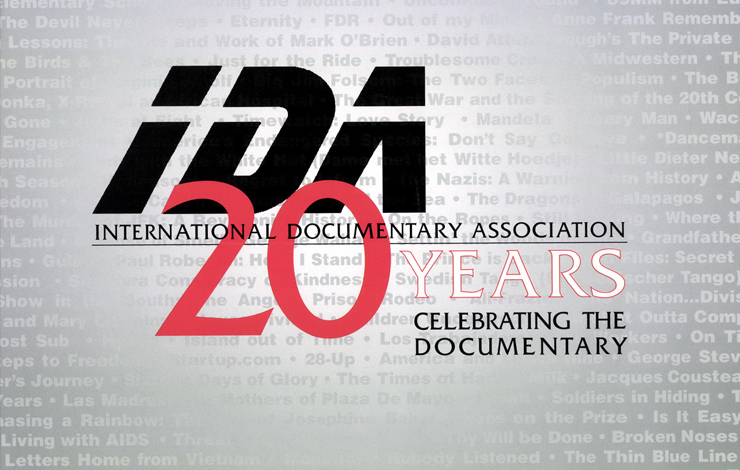
When the editor of this magazine asked me to speculate on what the next decade might hold in store for the documentary industry, I reminded him that I've only been on the job for eight months, and my crystal ball might be a bit cloudy. Fortunately, though, I was able to fall back on the collective expertise of our membership, which now includes 2,500 filmmakers from 52 different countries, as well as the inestimable wisdom of my predecessors, Betsy McLane and Linda Buzzell.
Inspired, as well, by the documentary Derrida, which I previewed at Sundance, I took the plunge. In Kirby Dick and Amy Ziering Kofman's provocative new film, French deconstructionist Jacques Derrida muses on the future. In English, he explains, the word "future" translates to, "what is predictable. Whereas in French, l'avenir is defined as 'whose arrival is unexpected and unpredictable.'" In that spirit, I've decided not to prognosticate, but to share my hopes for documentaries and the IDA. Fortuitously, the first months of my tenure have been enhanced by events I see as crucial to the continued growth of this artistic community. In January, for example, Robert Redford announced that Sundance Channel would spin off a cable network devoted exclusively to nonfiction shorts and features. Not to be outdone, the American Film Institute and Discovery Channel revealed plans for a new documentary festival, to begin in summer 2003 in Silver Spring, Maryland. Welcome news also came from the Academy of Motion Picture Arts and Sciences, which, having voted to create a separate branch for documentary films last year, will air a commemorative salute to documentaries during this year's telecast.
If anything good came in the wake of September 11, from the IDA's perspective it's that the media have been forced to offer something of substance to viewers and readers. Not only were audiences around the world transfixed by the horrific images of that day, but they also embraced such enlightening films as Saira Shah's Beneath the Veil and Unholy War. It's entirely possible that a generation of aspiring artists, transformed by that historic day and spurred by the wonders of digital technology, will turn to nonfiction for their fulfillment. You may recall that the same thing happened, 30 years ago, when the national calamity of Watergate sparked a rush to journalism schools.
In her essay, Betsy McLane reflects on the contention that the '90s were the Golden Era for documentary films. For this first decade of the new millennium to "go platinum," however, organizations like ours must find ways to set standards and establish context for the next wave of documentarians.
Moreover, we must learn how to embrace and exploit the so-called New Media, if for no other reason than to help filmmakers finally make a living from their craft. Our organization has to find ways for members to connect with the manufacturers of digital equipment, as well, and convince them to meet the specific needs and price points of documentary filmmakers. It's essential that these more portable, affordable and versatile tools be used to clear creative roadblocks at home, while also helping us reach out to those for whom a film school education currently is beyond reach.
It's fitting that the Sundance Channel would decide to create a network devoted to nonfiction work. Indeed, the cable industry (and, of course, its satellite cousins, DirecTV and EchoStar) might not have turned the economic corner in the first place, if it weren't for documentary product. From Day One to the present, each new network laid its foundation on material that ran the gamut from the World War II newsreels and nature films on A&E and Discovery to Real Sex and The Real World on HBO and MTV.
If we're successful at achieving any one thing in the next 10 years, though, it has to be raising our profile among both our peers and those who sponsor our efforts. The IDA has been in existence for 20 years, yet the documentary remains the stepchild of the movie industry. We may be based in Hollywood, but the studios have given us little to sustain our growth, despite the fact that many feature filmmakers got their starts in documentary and employ documentary technique in their work.
When an emissary from the White House called on Hollywood last fall to do its part in rallying the nation, two thoughts, seemingly diametrically opposed, came to mind: I thought of World War II, when the Roosevelt administration called on such filmmakers as John Huston, Frank Capra and John Ford to make documentaries about the war effort. A noble idea, that: government enlisting artists.
But then, these documentaries were propaganda; some of John Huston’s work, which depicted the gruesome side of war, was heavily censored. So then I thought about the real power of documentary to seek out the truth and remind us all what democracy truly is. Such grassroots, community media groups as Third World Newsreel and Paper Tiger Television—as well as the federally funded ITVS—are engaged in post-9/11 projects that seek out perspectives of Americans the mainstream media hasn’t sought out.
What is the outlook for the independent film and the IDA in the next decade? I look to the IDA mission, and think how wise and prophetic the founders were. My mandate for the future is it to stay true to our mission—to work passionately to promote the independent voices of nonfiction film and video internationally and continue to encourage and empower filmmakers.
Sandra Ruch is Executive Director of IDA.
